In this article
Imagine the split-second a trophy fish is thrashing beside the boat. You reach for your fishing pliers to safely remove the hook, but your cheap pliers are seized with rust, or the jaws twist uselessly under pressure. That moment of gear failure is more than frustrating—it’s a risk to both you, the fish, and your prized lure. This guide isn’t just about finding any fishing tools; it’s about investing in a valuable tool you can trust implicitly, ensuring every interaction at the water’s edge is successful.
This is more than a simple comparison review; it’s an ultimate fishing pliers field guide for selecting the right recreational angling gear. We’ll provide clear material education and decode the technical jargon that separates a disposable item from a piece of gear with lifetime durability, addressing the classic budget vs premium debate.
You will discover the three non-negotiable tiers of plier materials—forged titanium, aircraft-grade aluminum, and coated stainless steel—and learn which one matches your fishing environment and budget. We will explain why tungsten carbide cutters are the industry standard for slicing modern fishing line and why replaceable blades are a key indicator of long-term value. You will see our field-tested recommendations for three specific angler types: The Offshore Operator, The Mobile Angler, and The Value-Driven All-Rounder. Finally, you’ll understand the key scoring criteria—from corrosion resistance and length to jaw tip style and weight—we used to objectively rate every pair of pliers in this guide.
How to Choose the Right Fishing Pliers: An Expert’s Framework
To arm you with the objective knowledge needed to make a smart, confident choice, we’ve developed this expert framework. It moves beyond marketing claims, focusing instead on the tangible attributes that define a plier’s performance and longevity. We’ll break down the three most critical factors: material and construction, cutter type and performance, and functional handle ergonomics.
Why Do Material and Construction Matter Most?
The single most important factor in a plier’s performance is the material it’s made from. This choice dictates the tool’s price tier, weight, and ultimate lifespan, especially in corrosive saltwater environments. There is a clear hierarchy. Forged titanium is the apex predator: truly corrosion-proof with the highest strength-to-weight ratio available. Next is Machined 6061 T-6 aircraft aluminum, the lightweight champion, offering excellent corrosion resistance and precision. Finally, Coated Stainless Steel (and sometimes carbon steel or alloy steel), often with a protective ti-nitride coat, is the workhorse: strong, affordable, but it requires diligent care to be rust-resistant.
Just as critical is the manufacturing method. Forging metal under extreme pressure creates the densest and strongest possible tool, eliminating internal weaknesses. Machining carves pliers from a solid block of metal, resulting in high precision and strength. The most common method for budget models is Die-Casting, where molten metal is poured into a mold. This process can leave the material brittle and porous, creating flimsy jaws susceptible to cracking under torque.
Once you’ve chosen a material, the next critical component determines if the pliers can handle modern fishing lines.
How Critical is Cutter Performance for Today’s Angler?
Modern braided superlines present a unique challenge. Their tough, fibrous construction causes standard steel cutters to crush, rather than cut, the line, leading to dulling cutters and a frayed tag end that’s impossible to thread. The solution is Tungsten Carbide, an ultra-hard material that cuts braid like butter. Some premium models like the Danco Premio USA Pliers use exotic cobalt-titanium blades, but tungsten remains the gold standard. These side cutters are designed to not only cut braided line but also cleanly cut mono and cut fluoro.
Even the hardest blades can chip or dull. This is why the importance of replaceable cutters (and sometimes full replaceable carbide jaws) cannot be overstated. The ability to swap out a worn cutter extends the life of a premium tool indefinitely, transforming it from a consumable into a long-term investment. This single feature is a hallmark of well-designed fishing tools. This link connects our discussion of cutting modern lines to the foundational concept of understanding the unique properties of braided line which requires such a specialized braid-cutter.
A plier that cuts perfectly is useless if you can’t hold it securely when your hands are wet and slimy.
What Makes a Plier Ergonomic and Functional?
Performance on the water is about more than materials; it’s about how the good pliers feel and function in your hand. Non-slip, ergonomic handles, often made from a rubber over-mold or soft molded grips, are essential for safety, leverage, and excellent wet grip performance. A pistol-grip design, like on the Bubba Pistol Grip Stainless Steel Pliers, can provide superior control. One of the most crucial features is one-handed operation. Spring-loaded handles, which automatically keep the jaws open, are a must-have, allowing you to manage a fish and rod with one hand while using the pliers with the other.
Beyond basic gripping, the jaw tip style often integrates other tools. A needle-nose or long-reach style, like on the Rapala 11-inch Long Reach Pliers, is critical for deeply-hooked fish. A split-ring tip is invaluable for changing treble hooks on lures, while some models integrate a split-shot crimper or even an integrated sharpener. This thoughtful design makes for a versatile multitool. This discussion of plier jaw features connects directly to the foundational concept of matching the right hook to your target and the hooks you’ll be working with.
Pro-Tip: When choosing pliers, grip them with the same gloves you wear while fishing. A comfortable handle with bare hands might feel bulky and awkward with neoprene or sun gloves, impacting your dexterity when you need it most.
Now that we’ve covered the core principles of a high-performance plier, let’s look at how we applied this framework to select the best fishing pliers on the market.
Our Selection Process: How We Built This Guide
To build absolute trust, we must transparently detail our rigorous research process. Our recommendations are the result of comprehensive analysis, not brand loyalty. We are dedicated to providing unbiased advice for every angler skill level, from beginner to expert guide. Every fishing tool was evaluated against critical criteria: Corrosion Resistance, Cutter Performance, Ergonomics, Jaw Strength, and Portability, including the quality of the included lanyard and sheath. We also considered factors like warranty (including a 25-yr warranty on some models), hand-size recommendations, and suitability for specific target species like trout, bass, or musky.
Our selection process involved two phases. First, we conducted market analysis, including manufacturer specifications and expert reviews. Second, we curated the top-performing products, including models like the Accurate Piranha Pliers and Gerber Magniplier Fishing Pliers, and aligned them with distinct angler personas to ensure our recommendations are relevant to you.
If you choose to purchase a product through one of the links in this article, we may earn a small commission at no extra cost to you. This helps support our work. We only recommend gear we believe in.
The Best Fishing Pliers of 2025: Our Top Recommendations for Every Need
After exhaustive research, we’ve curated the top recommendations. Whether you’re a professional demanding a lifetime warranty or a weekend warrior looking for the best value, this is where you’ll find the perfect tool for the job.
Our Top Picks for The Offshore Operator
This angler operates in the harshest saltwater environments and demands absolute, “buy-it-for-life” reliability. Their gear, from Van Staal Titanium Pliers to heavy-duty rods, is a professional investment. Selections prioritize forged titanium and overbuilt, surf-tested construction for landing big sportfish like tuna or sharks.
Our Top Picks for The Mobile Angler
This angler—a kayaker, wade fisherman, or backcountry hiker—measures their gear in ounces. They prioritize lightweight design, compact tools for travel, and efficiency for activities like kayak fishing or high-alpine trout fishing. One-handed operation and a secure retention system are non-negotiable, because dropping your only pair of pliers can end a trip.
Our Top Picks for The Value-Driven All-Rounder
This is the largest segment of the market—serious anglers fishing a mix of freshwater and inshore saltwater who demand high performance but are also price-sensitive. They need good pliers for everything from working on baits on a bass boat to pulling hooks from catfish. They seek tools that “punch above their weight,” offering premium features at an accessible price.
Pro-Tip: For any steel or aluminum pliers used in saltwater, the most crucial maintenance step is a thorough freshwater rinse and dry after every trip. For steel pliers, a light coating of marine-grade oil on the jaws and pivot point will dramatically extend their rust-free life.
Conclusion
Choosing the right pliers is an investment in safety, efficiency, and enjoyment on the water. The decision ultimately comes down to a few core truths. Material is destiny; your plier’s primary material—titanium, aluminum, or steel—is the most important decision, dictating its corrosion resistance, its strength, and its price. Sharp cutters count; the ability to cleanly snip modern braided line is non-negotiable, making replaceable tungsten carbide cutters the benchmark for long-term service. Finally, ergonomics are essential; a secure, non-slip grip and spring-loaded handles are not luxuries, but core features that ensure effective one-handed use when you need it most.
The best fishing pliers are not the most expensive ones, but the ones perfectly aligned with your specific needs, whether you’re an offshore pro, a mobile minimalist, or a value-conscious all-rounder. Re-evaluate the pliers in your bag. If they’re rusted, weak, or can’t cut braid, use this guide to confidently choose a replacement that will serve you reliably for seasons to come.
Frequently Asked Questions about Fishing Pliers
Are expensive titanium fishing pliers really worth the money?
The titanium pliers value proposition is clearest for serious saltwater anglers. If you demand 100% corrosion immunity and maximum strength, yes, premium staal titanium pliers are a worthwhile long-term investment. They eliminate rust-related failure. For freshwater or budget-conscious fishermen, a high-quality anodized aluminum or coated stainless steel pliers, like the Piscifun Aluminum Fishing Pliers or KastKing Cutthroat Fishing Pliers, will offer excellent performance with proper care.
What is the best type of cutter for braided fishing line?
The industry standard for cleanly cutting braided line are cutters made from Tungsten Carbide. Its extreme hardness allows it to shear tough fibers rather than crush them. When choosing, always look for fishing pliers with replaceable blades, as this feature dramatically extends the tool’s usable life and ensures you always have a sharp edge.
How do I keep my fishing pliers from rusting?
To prevent rust, the most important piece of how-to maintenance is diligence. For any non-titanium pliers used in saltwater, a thorough freshwater rinse and dry after every trip is crucial. Proper storage tips include keeping them dry and applying a light coat of marine-grade oil to the jaws, cutters, and pivot point of steel pliers. This simple step will dramatically extend their rust-free life.
What size fishing pliers do I need?
The ideal fishing plier size depends on your target species and environment. A versatile 7-inch to 7.5-inch plier is the sweet spot for most applications, from inshore to freshwater bass fishing. For reaching deep into the mouths of large, toothy fish like musky, or for leverage on a rocking boat, longer 11-inch pliers are safer. For delicate trout work, smaller 5.5-inch cuda pliers or forceps are more appropriate.
Do I need different pliers for saltwater and freshwater fishing?
While you can use the same pliers, saltwater is extremely corrosive and will quickly destroy pliers not made from corrosion-proof (titanium) or highly rust-resistant (anodized aluminum) materials. The best fishing pliers for saltwater are always a wise investment. If you fish both, a tool like the Gerber Magniplier Fishing Pliers – Salt is a great choice, but always rinse it with fresh water after saltwater exposure.
Risk Disclaimer: Fishing, boating, and all related outdoor activities involve inherent risks that can lead to injury. The information provided on Master Fishing Mag is for educational and informational purposes only. While we strive for accuracy, the information, techniques, and advice on gear and safety are not a substitute for your own best judgment, local knowledge, and adherence to official regulations. Fishing regulations, including seasons, size limits, and species restrictions, change frequently and vary by location. Always consult the latest official regulations from your local fish and wildlife agency before heading out. Proper handling of hooks, knives, and other sharp equipment is essential for safety. Furthermore, be aware of local fish consumption advisories. By using this website, you agree that you are solely responsible for your own safety and for complying with all applicable laws. Any reliance you place on our content is strictly at your own risk. Master Fishing Mag and its authors will not be held liable for any injury, damage, or loss sustained in connection with the use of the information herein.
Affiliate Disclosure: We are a participant in the Amazon Services LLC Associates Program, an affiliate advertising program designed to provide a means for us to earn advertising fees by advertising and linking to Amazon.com. As an Amazon Associate, we earn from qualifying purchases. We also participate in other affiliate programs and may receive a commission on products purchased through our links, at no extra cost to you. Additional terms are found in the terms of service.





